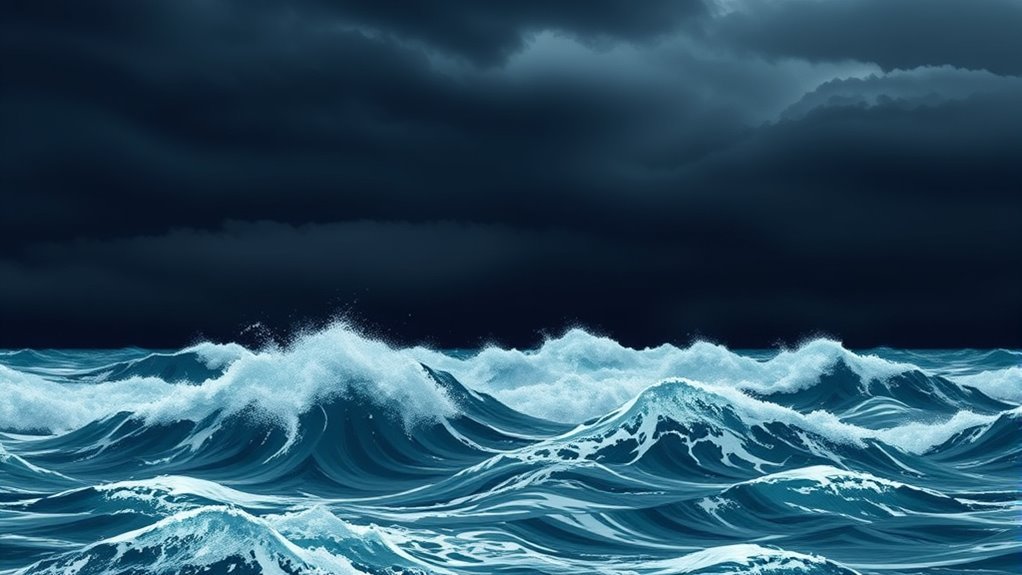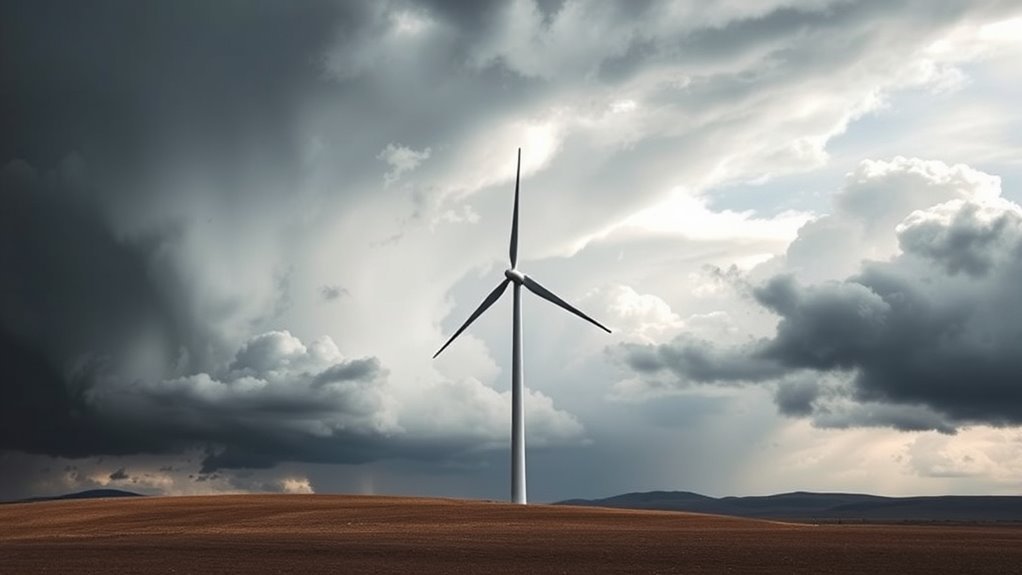Studies reveal that squall formation and intensification are influenced by several key factors. Atmospheric instability, fueled by warm, humid air, plays a crucial role. The presence of moisture improves convective activity, while wind shear organizes storm systems. Topography also impacts squalls, as mountains can force air upwards, intensifying precipitation and wind. These elements interact to create sudden changes in weather conditions. Further exploration sheds light on the complexities of squall phenomena and their consequences.
Main Points
- Studies show that squalls form from thunderstorms or frontal systems, driven by rapid changes in wind speed and direction.
- Atmospheric instability, fueled by warm, humid air, contributes to the formation of towering cumulonimbus clouds associated with squalls.
- Wind shear plays a critical role in enhancing the strength and organization of squall lines, leading to more intense weather events.
- Topographical features, such as mountains and valleys, significantly influence local wind patterns, affecting squall intensity and precipitation.
- Advances in forecasting techniques, including machine learning and high-resolution satellite data, improve the prediction and monitoring of squall conditions.
Understanding the Basics of Squalls
Squalls are sudden, intense bursts of wind and rain that can occur in various weather conditions. They are often defined by rapid changes in wind speed and direction, leading to turbulent conditions that can pose hazards to both land and sea activities.
Typically, squalls can develop from thunderstorms or frontal systems and may last from a few minutes to several hours.
The formation of a squall is usually associated with localized atmospheric disturbances, which can result in heavy precipitation and strong gusts. These meteorological phenomena can vary notably in scale and intensity, influencing their potential impact.
While squalls can occur in a range of climates, they are particularly common in coastal regions, where warm, moist air meets cooler air masses.
Understanding the basic features and triggers of squalls is essential for predicting their occurrence and mitigating the risks they pose to the environment and human activities.
The Role of Atmospheric Instability

Instability in the atmosphere is a crucial factor influencing the development of squalls. When the air in the lower layers becomes warmer and more humid than the air above, it creates a buoyant force that can lead to vertical air movement. This rising air can result in the formation of cumulonimbus clouds, which are often associated with squalls.
As the warm, moist air ascends, it cools, condensing into droplets and releasing latent heat, further enhancing instability. This process can generate strong updrafts and downdrafts, characteristic of squall lines.
Furthermore, atmospheric instability is often accompanied by wind shear, which can intensify the squall's strength and organization. The combination of warm, moist air and the dynamic environment facilitates the rapid development and intensification of squalls, making atmospheric instability a critical component in understanding and predicting these weather phenomena.
Factors Contributing to Squall Formation
Several factors contribute to the formation of squalls, with atmospheric conditions playing a critical role. One important element is the presence of moisture in the air, which can improve instability. Warm, moist air rising rapidly creates an environment conducive to squall development.
Additionally, wind shear, or the variation of wind speed and direction with altitude, is essential; it can promote the organization of storm systems.
Temperature gradients also influence squall formation, as contrasting air masses can lead to the initiation of convective activity. Moreover, the presence of a triggering mechanism, such as a cold front or a low-pressure system, can act as a catalyst for squall development.
Finally, the vertical structure of the atmosphere, including the lapse rate, is fundamental in determining how efficiently these factors interact to produce intense squall conditions. Understanding these elements is imperative for predicting and monitoring squall events effectively.
The Impact of Topography on Squalls

Topography plays an essential role in the formation and intensification of squalls.
Variations in terrain can influence local wind patterns and contribute to the development of these intense weather phenomena.
Additionally, elevation changes can improve the uplift of air, further affecting squall characteristics.
Terrain Influence on Squalls
While various meteorological factors contribute to the formation of squalls, the influence of terrain plays an essential role in shaping their intensity and behavior.
Topographical features such as mountains, valleys, and bodies of water can greatly disrupt airflow, leading to the development of squalls. For instance, mountains can act as barriers, forcing air to rise and cool, which may improve precipitation and wind speeds associated with squalls.
Additionally, valleys can funnel winds, amplifying the squall's impact as they converge. Understanding these terrain influences is critical for predicting and managing squall events effectively.
- Mountains can improve precipitation levels.
- Valleys may funnel and amplify winds.
- Bodies of water can influence local humidity.
- Urban areas may create heat islands, affecting squall dynamics.
Elevation and Wind Patterns
The interplay between rise and wind patterns greatly influences squall development and behavior. As air encounters elevated terrain, it is forced to ascend, leading to cooling and condensation, which can improve precipitation within squalls. This orographic lift often results in localized intensification, producing stronger squalls on windward slopes.
Conversely, descending air on the leeward side can create dry zones, altering squall intensity and duration. In addition, variations in elevation can disrupt prevailing wind patterns, leading to localized turbulence and increased shear. Such changes may initiate or exacerbate squall formation, particularly in regions where topography is pronounced.
Understanding these interactions is vital for predicting squall behavior and mitigating potential impacts on affected areas.
Advances in Squall Forecasting Techniques

As meteorologists continue to refine their methods, advances in squall forecasting techniques have emerged, considerably improving predictive accuracy. Innovations in technology and data analysis have transformed how forecasters evaluate squall events. The integration of high-resolution satellite imagery and real-time radar data allows for more precise monitoring of atmospheric conditions contributing to squall formation.
Additionally, machine learning algorithms are increasingly utilized to identify patterns in historical squall data, enhancing the reliability of forecasts.
- Improved satellite and radar technology improves real-time data collection.
- Machine learning applications enable better pattern recognition in historical data.
- Enhanced numerical weather prediction models offer greater detail in forecasts.
- Collaboration among meteorological organizations promotes the sharing of best practices and research findings.
These advancements collectively contribute to a more proactive approach in squall forecasting, ultimately aiding in mitigating risks associated with severe weather events.
Case Studies on Notable Squall Events
Advancements in squall forecasting techniques have greatly improved the ability to analyze past events, leading to a deeper understanding of squall behavior. Notable case studies, such as the 2011 Virginia squall line, demonstrated the rapid intensification of wind speeds, resulting in considerable damage across multiple states. Meteorologists noted how the interaction of a cold front with warm, moist air contributed to the squall's development.
Another notable event occurred in 2014, when a squall line moved through the Midwest, producing severe thunderstorms and hail. Analysis revealed that terrain and urban heat islands played a vital role in enhancing the squall's intensity.
These case studies illustrate the complex dynamics involved in squall formation, emphasizing the need for ongoing research. By examining historical events, meteorologists can refine forecasting models, eventually improving the accuracy of squall predictions and enhancing the understanding of their impact on weather systems.
Implications for Public Safety and Response Strategies
Understanding the consequences of squall events is crucial for enhancing public safety and developing effective response strategies. Squalls can rapidly intensify, posing considerable threats to individuals and infrastructure.
As a result, communities must prioritize preparedness and response protocols that mitigate risks associated with such weather phenomena.
- Implementing early warning systems to alert residents in advance.
- Training emergency response teams to handle sudden squall conditions.
- Educating the public on recognizing signs of impending squalls and safe practices.
- Developing infrastructure resilient to intense wind and rain associated with squall events.
Common Questions
How Do Squalls Differ From Thunderstorms?
Squalls differ from thunderstorms primarily in duration and intensity. Squalls are short-lived, intense wind events often associated with a line of showers, while thunderstorms feature lightning, longer duration, and various severe weather phenomena.
What Tools Are Used to Measure Squall Intensity?
To measure squall intensity, meteorologists utilize tools such as Doppler radar, anemometers, and weather satellites. These instruments provide data on wind speed, precipitation rates, and atmospheric conditions, essential for understanding squall behavior and potential impacts.
Can Squalls Occur in Winter Months?
Squalls can indeed occur during winter months. Their formation is influenced by atmospheric conditions, which can create sudden, intense bursts of wind and precipitation, regardless of the season, including the colder winter period.
Are Squalls More Common in Certain Geographical Areas?
Squalls are indeed more common in specific geographical areas, often influenced by local climate conditions. Coastal regions, particularly those with warm ocean currents, frequently experience these intense weather phenomena, while mountainous terrains can also contribute to their formation.
How Do Squalls Affect Marine Navigation and Safety?
Squalls considerably impact marine navigation and safety, creating hazardous conditions for vessels. Sudden wind shifts and reduced visibility can lead to accidents, prompting the need for improved weather monitoring and preparedness among mariners to mitigate risks.

